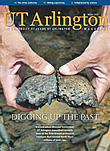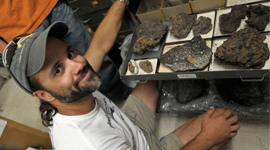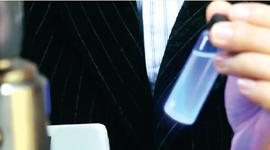Creating the next Einsteins
Expertise in science, technology, engineering and mathematics is key to remaining competitive in the global marketplace. UT Arlington has embarked on an aggressive campaign to interest more students and educate more teachers in these crucial areas.
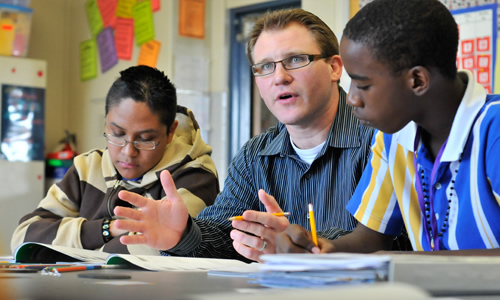
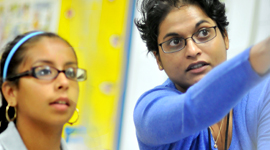
The MAVS program places math graduate students like Padmini Veerapen in Arlington high school and junior high classrooms.
In hopes that piquing a child’s interest may lead to a lifelong love of science, the UT Arlington ExxonMobil Science Ambassadors educate and entertain thousands of school children who visit the University every year.
Since its inception in 2007, the ambassador program, supported by a grant from the ExxonMobil Foundation, has delivered about 300 presentations to more than 20,000 students. The ambassadors, all UT Arlington science majors, keep the show moving with demonstrations ranging from setting money on fire (without actually destroying it) to creating small (and controlled) explosions.
Carrie Baum, Science Education and Career Center assistant director, says the idea is to show kids how much fun science can be.
“We have some flashy demonstrations and some humorous elements, and the kids have a wonderful time at the show. We hope they will carry this enjoyment back to their classrooms and perhaps be more receptive to the science that they are learning in school. While our main focus is not transmitting facts, we do cover a lot of scientific concepts in the show.”
A multicultural group, the Science Ambassadors demonstrate another important point by their very existence. Watching them perform, students of various ethnicities see someone with whom they can identify. Since minority students are underrepresented in the sciences, that can be an important recruiting tool.
“There are a lot of smart people out there who should be getting into science but are not,” Dr. Hale says.
Baum says the goal is to attract more students to science careers. “A one-time educational experience is seldom life-changing,” she adds, “but we like to think we’re giving them a nudge in the right direction.”
Eighth-graders from Fort Worth’s Riverside Middle School are getting more than a one-time experience at UT Arlington. They’re coming on campus twice a year for full-day math-science retreats. The program began shortly after the Fort Worth Rotary Club partnered with the school and began looking for ways to help students.
“We told them that our problem areas tended to be math and science,” Principal Daniel Scroggins says. “Someone in Rotary had a contact at UTA, and that led to a meeting with several professors. That led to a brainstorming session on how to best help our kids, and that led to the camp.
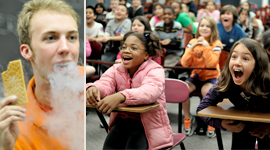
Science Ambassador Trevor Henry demonstrates the effects of liquid nitrogen for fourth-graders from Martha Reid Elementary School.
“I just said, ‘Here are the areas we have trouble with,’ and they ran with it. Everything is hands-on and the kids are totally involved. We know it’s effective. The kids come back to class, and they can all explain what they did. The science is clear to them, and they have a great time.”
The entire eighth grade has a great time, because every class attends. Six to eight buses, filled with more than 300 students, head to the UT Arlington/Fort Worth Center for a fun day of learning.
“The kids just think it’s great,” Scroggins says. “And I think it helps some of them get more of a mind-set to go to college.”
Math Professors Tuncay Aktosun and Theresa Jorgensen have been involved in the effort from its inception, and they see the retreats as golden opportunities.
“The goal is to involve the students in mathematics and science activities, encourage them to study mathematics and science at higher levels, and encourage them to attend college,” Dr. Aktosun says.
Early results appear promising. Riverside Middle School has seen improvement in math and science TAKS scores (a goal both for UT Arlington and Riverside administrators), and the institutions have established a good working relationship.
“Our undergraduate and graduate students have acted as mentors and helpers in the events we have organized,” Dr. Jorgensen says. “I think we have planted in at least some of these middle school students the seeds so that they desire to attend college and study STEM (science, technology, engineering and mathematics) fields in the future.”
Other budding middle school scientists come to UT Arlington each summer to attend the ExxonMobil Bernard Harris Summer Science Camp. Dr. Harris, a physician and former astronaut, founded the camp in 1994, and ExxonMobil became its sponsor in 2006.Harris, the first African American to walk in space, attends the two-week residential camp, which engages students in hands-on science experiments and innovative programs designed to encourage their continued participation in STEM fields. The camp is free, and students are selected based on grades, ethnicity and socioeconomic status.
“We take kids who are already interested in math and science and try to turn them into the next generation of scientists, mathematicians and engineers,” Hale says. “Minority students are just not coming into these fields, and we want to encourage them. There’s a lot of talent out there being wasted.”
The UT Arlington STEM initiatives don’t focus solely on bringing future students to campus. Other programs seek to place highly qualified math and science teachers in schools.
According to the Business-Higher Education Forum in Washington, D.C., districts nationwide face shortages of math and science teachers. In at least 10 states, fewer than six out of 10 middle school science teachers were certified when the Council of Chief School Officers compiled a report in 2007.
Another report from researchers at UT Austin found that the teacher shortage has increasingly meant that less-qualified teachers fill classrooms, particularly at schools with low-income students.
Among the other key findings: The most acute teacher shortages in Texas are in secondary math and science. Since 2004 those deficiencies have increased dramatically, especially in high school science where the shortage has jumped by more than 80 percent. Projections of future supply and demand suggest that the dearth will continue to worsen.
Through a variety of grant and scholarship programs, UT Arlington is stepping into the breach. The University is one of 107 nationwide committed to the Science and Mathematics Teacher Imperative. Participating institutions agree to increase substantially a diverse pool of highly qualified science and mathematics teachers in their states. UT Arlington has promised to increase its math and science teacher output by 300 percent over the next decade.
Some of those graduates likely will be involved with the Mathematically Aligned Vertical Strands (MAVS) Connecting Mathematics Research, Pedagogy and Outreach for GK-12 Fellows and Teachers program. Funded by a $2.85 million National Science Foundation grant, the program creates teams of UT Arlington math graduate students and secondary math teachers in Arlington schools with high minority student populations. The first participating schools are Sam Houston High School and its feeder junior highs.
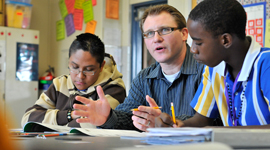
Math graduate student Justin Blackwell tutors seventh-graders at Carter Junior High in Arlington.
Begun last fall, the program aims to create a transition that steadily moves students through secondary school and toward research-level mathematics at the University. It revolves around teams of eight UT Arlington fellows paired with eight teachers from the participating Arlington schools. Fellows spend an average of 10 hours per week in the schools, learning teaching techniques and sharing their research.
Mathematics Associate Professor Minerva Cordero says the fellows and public school teachers “collaborate to develop and deliver lessons that reflect a robust understanding of the vertical alignment of the mathematics curriculum and connections to research mathematics.”
In addition, the project will develop research and teaching seminars, mentoring triads and teaching quads. The triads consist of a fellow, his or her research adviser and a MAVS faculty mentor. Teaching quads consist of two MAVS fellows with a mentor junior high and a mentor high school math teacher.
“The project promotes an innovative model for addressing the acute needs of underserved student populations to improve mathematics education from junior high to the graduate level,” says Dr. Cordero, who directs the program.
In another bid to develop more math and science educators, UT Arlington is now part of the UTeach program, which beginning in fall 2010 will offer stipends of $100-$125 for students to simply take a one-credit course introducing them to teaching elementary and secondary math and science. Supported by the Texas Instruments Foundation and the National Math and Science Initiative, UTeach Arlington involves collaboration between the College of Science and the College of Education and Health Professions.
“We’re casting the net wide,” Hale says. “We’ll invite in math and science majors who have any interest at all in teaching.”
Additional funding for future teachers is available through the Robert Noyce Teacher Scholarship Program—another education-science partnership—which offers $10,000 scholarships to juniors, seniors and post-baccalaureate students as they complete their degrees and teacher certification.
The support is there. The need is definitely there. And now the money is there. Perhaps soon the science and math teachers will be there in abundance as well, because those future scientists and mathematicians like Shannon really do matter.



